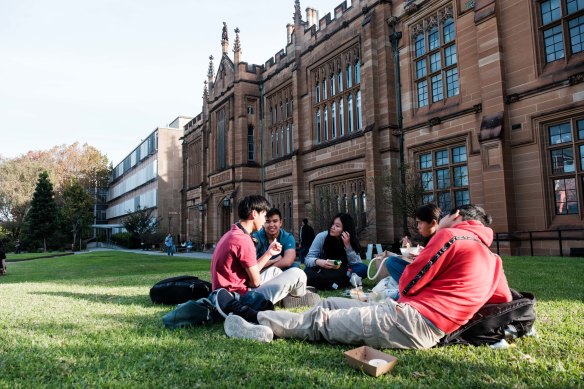- Exclusive
- National
- International students
Labor’s international student caps ignite recession fears
A dramatic drop in international students would push Australia’s fragile economy into a recession, a leading economist says, as Labor moves ahead with its controversial plan to limit foreign enrolments as part of its bid to drive down migration.
Professor Richard Holden, an economist from UNSW Business School, said his analysis showed a return to 2019 international student numbers would cause an $11.6 billion hit to Australia’s economy in 2025 alone, almost 0.5 per cent of gross domestic product.

An economist has warned Australia could enter a recession if there’s a large drop in international students. Credit: Oscar Colman
“That could easily be enough to tip Australia into an actual recession,” he said. “It’s not just the tuition fees that international students pay. They pay rent, they spend money on food and entertainment, and they travel. And that spending in the broader economy … that’s where a lot of businesses are really struggling at the moment.”
The federal government has used international students as a key lever to meet its goal of slashing net immigration from 520,000 in the 2023 financial year to 260,000 by June next year.
Both the government and the opposition have linked the post-COVID-19 surge in international students to housing stress, with migration shaping as a key battleground in the lead-up to the next election.
In May, Education Minister Jason Clare introduced a bill to allow him to cap international student numbers at both course and provider levels, but maintains the proposed limits have not been finalised.
Holden has based his economic analysis on the impact of caps if the government limited universities to 2019 student numbers.
Holden has based his economic analysis on the impact of caps if the government limited universities to 2019 student numbers – a scenario modelled by some institutions and discussed in the sector – which he said would amount to a 20 per cent reduction in foreign enrolments.
In 2023, there were 437,485 international students in Australian universities. Holder’s analysis, which does not include the vocational sector, said based on year-to-date growth rates, this figure would rise to 529,897 in 2024.
Australia’s economy grew 1.1 per cent in the year to March, but the country has been in a “per capita” recession – negative growth in gross domestic product per person – for more than a year.
Holden said even if Australia’s “per person” economic growth improved from -1.3 per cent a year to -1 per cent in 2025, actual economic growth would be just 0.3 per cent. A 20 per cent reduction in international student numbers would wipe out this growth, he said, reducing economic growth to -0.16 per cent and triggering a recession.
The Education Department puts the total export value of higher education international students at $31.8 billion for 2023.
But Holden’s analysis said this understated the true economic value to Australia from these students as it did not capture how it reverberated through the economy through job creation and the spending of businesses and individuals.
He argued the real economic value of international university students in 2024 would be $57.7 billion.
“I’m worried about the fragility of the Australian economy,” Holden said. “We have record levels of insolvency and 15 per cent of those are in the accommodation and food sector, so I think you would notice a drop in international students across the economy, but you might notice it particularly in some of these sectors which are already struggling.”
Centre for Independent Studies chief economist Peter Tulip, a former senior research manager for the Reserve Bank, said a significant cut in international students would have a small but noticeable effect on rental prices, but would ultimately make the country poorer.
“This would reduce housing pressures, but it’s an unattractive way of doing it,” he said. “Education is our fourth-largest export market; it’s how we pay for our imported TVs and cars and clothes. If you stifle our export markets, our quality of living goes down and we can’t pay for all of those good things.”
The move to cap international student numbers comes amid huge growth in international student numbers over the past decade, with some institutions such as Sydney University and Melbourne University recording at least 45 per cent foreign student cohorts.
In a report this week, Victoria University’s Mitchell Institute suggested universities could increase their international student numbers even if a cap was implemented. It said the government should allow institutions to enrol a base number of international students, and anything above that should be based on an agreed ratio of domestic to international students.
It said institutions should then be allowed to enrol above their base and ratio amount based on other criteria – for example, demonstrating they have sufficient student housing.
Clare said cap limits had not been finalised but would ensure international education kept its “social licence”.
”We are consulting with leaders from the international education sector to make sure we get the design and implementation of these critical reforms right, with implementation to begin from January 1, 2025,” he said.
Start the day with a summary of the day’s most important and interesting stories, analysis and insights. Sign up for our Morning Edition newsletter.